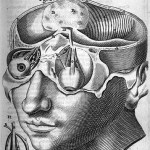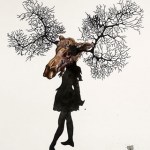neurons
New research from the Weizmann Institute of Science reveals that "cells in our brain form little hexagonal grids that keep us oriented, map-like, in our surroundings." Weizmann's resident blogger describes this finding as "a pyrotechnic flash of insight that changes how we understand the brain to work." Game developers delight; this discovery shows "that you can really apply mathematical models to understand how our mammalian brains get their bearings." It may also have immediate implications for understanding human brain disorders such as vertigo. Meanwhile, on ERV, Abbie Smith explores a…
With 2001 in the rear-view mirror, there have been no little green men, no meal-replacement pills, no flying automobiles, no space odysseys. But as big-budget plans to model the human brain prove, proponents of artificial intelligence remain hopeful. In its most literal sense, AI exists already: encoded and executed, endowed with sensors, lenses and microphones, connected to the internet, and stuck in your pocket. But how intelligent does a machine have to be before our worst nightmares come true? Intelligent enough to pass a Turing test? Intelligent enough to nuke the human race? And/or…
Aristotle thought that there could be no lasting void in the natural order, that any emptiness would be instantaneously filled. Of course Aristotle was full of batty ideas. But this one came to be rephrased by philosophers and Vulcans alike as "nature abhors a vacuum," enduring as a powerful metaphor if not a precisely factual truth. In terms of critical thinking, scientists too abhor a vacuum, and are usually eager to fill in the blanks. On Pharyngula, PZ Myers criticizes a review of long-established brain anatomy, freshened with primary colors and a hypothesis that makes no sense.…
Elizabeth Norton has an interesting write-up in Science Now. Some years ago, after a long period of suspicion, it was seemingly demonstrated that neurogenesis (the formation of new neurons) happened in the human nose. This research was based on the identification of proteins that would be associated with the early formation of baby neurons. Therefore, it was not possible to prove that full grown and functioning neurons were being grown in the nose, but it was assumed to be a reasonable possibly.
However, it really isn't a reasonable possibility. If there was an Intelligent Designer, then…
THIS image by Dominik Paquet of Ludwig-Maximilians-Universität in Munich is one of the winners of the 2009 Nikon Small World Photomicrography competition. It's a confocal fluoresence microscopy image of zebrafish larvae expressing a mutant form of human Tau protein, which forms the neurofibrillary tangles that are a pathological hallmark of Alzheimer's Disease. The work is described in this recent paper.
Below are two more images from the competition.
This image of pyramidal cells in the mouse cerebral cortex was created by Celine Plachez of the University of Maryland School of Medicine.…
A paper by researchers from Princeton University, just published in the open access journal PLoS One, describes a new virus-based technique for probing the connections between neurons while simultaneously monitoring their activity in live animals. Various methods are available for studying the activity of neurons and how they are connected to one another, but examining the co-ordinated activity of multiple nerve cells in neural circuits has, until now, posed a big challenge, because none of them can monitor both activity and connectivity at the same time.
The earliest method for tracing…
Itching is an unpleasant sensation that drives us to scratch reflexively in an effort to remove harmful substances from our body. It's also how I get most of my physical activity for the day. Not being able to scratch an itch is intensely frustrating and many scientists have long described itch as the milder cousin of pain.
But a team of scientists from Washington University's Pain Center (I wonder if they have problems with recruitment) have discovered a group of neurons in the spines of mice that are specific to itch but not to pain. Remove them, and mice hardly ever scratch when they're…
Ion channels, chica.
Hat Tip: Virginia Hughes. Who also has something interesting on Coffee.
A couple of weeks ago, I wrote about propranolol, a drug that can erase the emotion of fearful memories. When volunteers take the drug before recalling a scary memory about a spider, it dulled the emotional sting of future recollections. It's not, however, a mind-wiping pill in the traditional science-fiction sense, and it can't erase memories as was so widely reported by the hysterical mainstream media.
The research that's published today is a different story. Jin-Hee Han from the University of Toronto has indeed found a way to erase a specific fearful memory, but despite the…
As of today, SEED has a new look and a new occasional writer. . . me! ;)
See my little essay on Christopher Reiger's Synesthesia #1 here, on the culture page. Then go explore the rest of the site. . . the new design is pretty sweet. They even have a SCIART tag for pieces like mine.
Ever since I started to learn about brains, back in the mid 1980s, from some really brainy brain experts like Terry Deacon and Joe Marcus, I always knew that glial cells were important. But I now read in current material in Nature Neuroscience, that "A decade ago, glia were the neglected stepchildren of neuroscience. Although glia outnumber neurons by about ten to 1 in the adult human brain, providing support for neurons has traditionally been viewed as their primary function. Glial biology has come into its own recently, as researchers have shown that glia are critical for the development…



